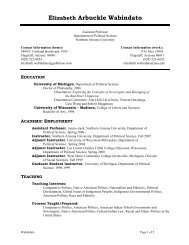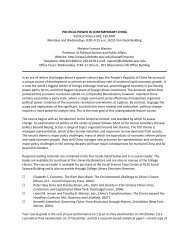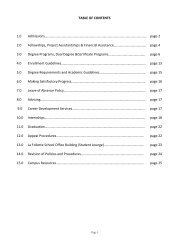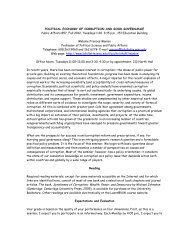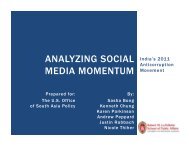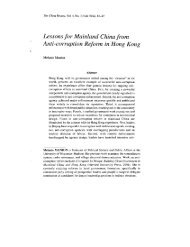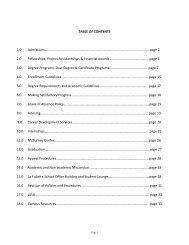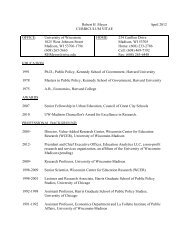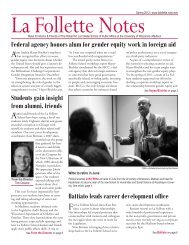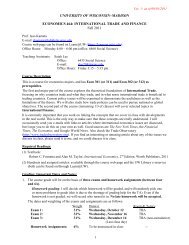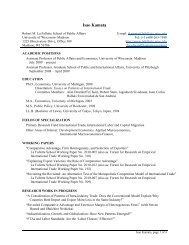SAVE Commission's findings - La Follette School of Public Affairs ...
SAVE Commission's findings - La Follette School of Public Affairs ...
SAVE Commission's findings - La Follette School of Public Affairs ...
Create successful ePaper yourself
Turn your PDF publications into a flip-book with our unique Google optimized e-Paper software.
socialization, stewardship and entrepreneurship<br />
in youth—might have an even greater positive<br />
impact if they are more closely tied to other<br />
activities.<br />
Youth apprenticeship<br />
programs and the<br />
conservation corps are<br />
two programs that operate<br />
in relative isolation<br />
from each other and yet<br />
have similar objectives,<br />
exposing youth to the<br />
rhythm <strong>of</strong> work. However,<br />
there are questions<br />
about the ability <strong>of</strong> the WCC to attract workers.<br />
All <strong>of</strong> the programs represent a considerable<br />
investment <strong>of</strong> time, money and effort, yet<br />
they are generally uncoordinated and fail to reinforce<br />
each other and serve youth as a whole.<br />
For youth to connect, they need to be involved<br />
in the public system. Volunteer efforts<br />
like Badger Boys and Girls State and the Strive<br />
Foundation provide lessons and questions for<br />
elected <strong>of</strong>ficials, business owners and all concerned<br />
about how long we can go with youth<br />
believing more and more they have no stake in<br />
the system.<br />
OLDER ADULTS<br />
Many <strong>of</strong> the state’s programs and relationships<br />
with older adults are driven by federal<br />
programs and rules. The aging <strong>of</strong> society will<br />
result in major fiscal challenges to the federal<br />
government, state government and, <strong>of</strong> course,<br />
all taxpayers. (Wisconsin will see a sharp increase<br />
in older adults after the year 2000.)<br />
“With the breakdown <strong>of</strong> the<br />
family and educational system<br />
we are guaranteeing the<br />
continued recycling <strong>of</strong> poverty.”<br />
Martin Schreiber, former governor<br />
Under the Commission’s theme <strong>of</strong> selfreliance<br />
and shared responsibility, questions<br />
must be asked at all levels <strong>of</strong> government and<br />
in all sectors about<br />
what barriers exist to<br />
older adult self-reliance.<br />
In a bureaucratic<br />
sense, barriers have<br />
been erected unwittingly<br />
in the Department<br />
<strong>of</strong> Health and<br />
Social services through<br />
different and competing<br />
cultures and purposes in different divisions.<br />
This leads to counter-productive competition,<br />
duplication and poor coordination.<br />
In a larger sense, the issue <strong>of</strong> how to cope<br />
with an aging society reaches from Green <strong>La</strong>ke<br />
to Milwaukee County. It is important for the<br />
entire state to address the challenge. However,<br />
the assumption that “government can do it all”<br />
is no longer operative. Now families, including<br />
extended families (as was the case years ago),<br />
have primary responsibility for elder care. Thus,<br />
a review <strong>of</strong> the barriers to families caring for<br />
older adults is needed.<br />
Equally important is tapping the capacity<br />
<strong>of</strong> seniors for continued service in household,<br />
community and school. Many seniors now serve<br />
as mentors, storytellers, classroom aides and<br />
volunteers. The system could be in place where<br />
many more would volunteer if legal, scheduling,<br />
transportation and structural barriers were<br />
removed.<br />
Actions<br />
6.1<br />
Consolidate youth<br />
functions.<br />
6.2<br />
Plan for aging <strong>of</strong> society.<br />
Tom Frazier, Madison<br />
“We need a culture <strong>of</strong><br />
self-reliance when it<br />
comes to older adults.”<br />
John A. Huebscher,<br />
Madison<br />
“State government has<br />
a vital role as a buffer to<br />
protect those in<br />
Wisconsin who are<br />
disadvantaged by birth.”<br />
Gerald Whitburn,<br />
DHSS Secretary<br />
“The aging population<br />
represents a significant<br />
fiscal challenge to the<br />
state in the long term.”<br />
Judge Moria Krueger<br />
“The entire juvenile<br />
justice system should<br />
be focused on how to<br />
go out <strong>of</strong> business, how<br />
to develop prevention<br />
and intervention<br />
strategies that reduce<br />
the number <strong>of</strong> clients in<br />
the system.”<br />
R E S U L T S<br />
Generations that<br />
connect will:<br />
1 Focus government programs<br />
dealing with the young and the<br />
elderly on efficient delivery, not<br />
program boundaries or agency<br />
authority.<br />
2 Change the focus <strong>of</strong> programs<br />
for youth and elderly to include<br />
using the population as<br />
participants and problem<br />
solvers, not just service<br />
recipients.<br />
3 Enable state government<br />
employees to ask not what their<br />
program can do for youth and<br />
the elderly, but what should be<br />
done across problems in<br />
cooperation with these<br />
populations.<br />
4 Bring youth and elderly into<br />
programs as fellow citizens, not<br />
as clients, and treat them with<br />
dignity and respect.<br />
5 Allow the family, linking across<br />
all generations, to be viewed as<br />
the focus entity instead <strong>of</strong> four<br />
social workers for each person<br />
in the family.<br />
6 Reduce the cost <strong>of</strong> services<br />
through program consolidation<br />
and coordination.<br />
CITIZEN • COMMUNITY • GOVERNMENT — WISCONSIN: THE 21 ST CENTURY 23



